warning light FIAT DOBLO COMBI 2015 2.G Workshop Manual
[x] Cancel search | Manufacturer: FIAT, Model Year: 2015, Model line: DOBLO COMBI, Model: FIAT DOBLO COMBI 2015 2.GPages: 323, PDF Size: 46.77 MB
Page 142 of 323
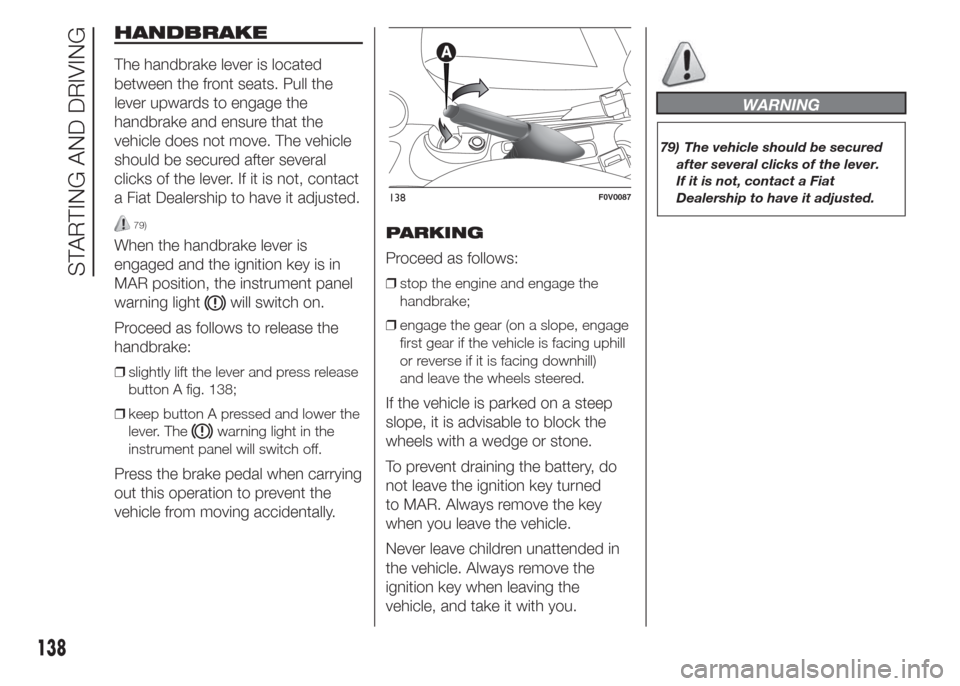
HANDBRAKE
The handbrake lever is located
between the front seats. Pull the
lever upwards to engage the
handbrake and ensure that the
vehicle does not move. The vehicle
should be secured after several
clicks of the lever. If it is not, contact
a Fiat Dealership to have it adjusted.
79)
When the handbrake lever is
engaged and the ignition key is in
MAR position, the instrument panel
warning light
will switch on.
Proceed as follows to release the
handbrake:
❒slightly lift the lever and press release
button A fig. 138;
❒keep button A pressed and lower the
lever. The
warning light in the
instrument panel will switch off.
Press the brake pedal when carrying
out this operation to prevent the
vehicle from moving accidentally.PARKING
Proceed as follows:
❒stop the engine and engage the
handbrake;
❒engage the gear (on a slope, engage
first gear if the vehicle is facing uphill
or reverse if it is facing downhill)
and leave the wheels steered.
If the vehicle is parked on a steep
slope, it is advisable to block the
wheels with a wedge or stone.
To prevent draining the battery, do
not leave the ignition key turned
to MAR. Always remove the key
when you leave the vehicle.
Never leave children unattended in
the vehicle. Always remove the
ignition key when leaving the
vehicle, and take it with you.
WARNING
79) The vehicle should be secured
after several clicks of the lever.
If it is not, contact a Fiat
Dealership to have it adjusted.
138F0V0087
138
STARTING AND DRIVING
Page 143 of 323
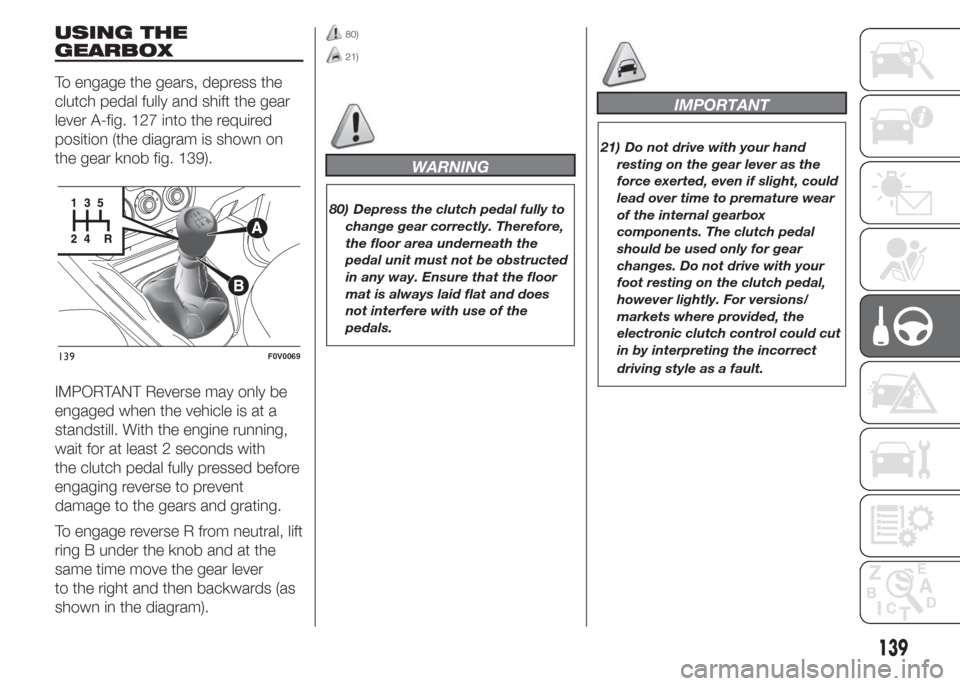
USING THE
GEARBOX
To engage the gears, depress the
clutch pedal fully and shift the gear
lever A-fig. 127 into the required
position (the diagram is shown on
the gear knob fig. 139).
IMPORTANT Reverse may only be
engaged when the vehicle is at a
standstill. With the engine running,
wait for at least 2 seconds with
the clutch pedal fully pressed before
engaging reverse to prevent
damage to the gears and grating.
To engage reverse R from neutral, lift
ring B under the knob and at the
same time move the gear lever
to the right and then backwards (as
shown in the diagram).
80)
21)
WARNING
80) Depress the clutch pedal fully to
change gear correctly. Therefore,
the floor area underneath the
pedal unit must not be obstructed
in any way. Ensure that the floor
mat is always laid flat and does
not interfere with use of the
pedals.
IMPORTANT
21) Do not drive with your hand
resting on the gear lever as the
force exerted, even if slight, could
lead over time to premature wear
of the internal gearbox
components. The clutch pedal
should be used only for gear
changes. Do not drive with your
foot resting on the clutch pedal,
however lightly. For versions/
markets where provided, the
electronic clutch control could cut
in by interpreting the incorrect
driving style as a fault.
139F0V0069
139
Page 145 of 323
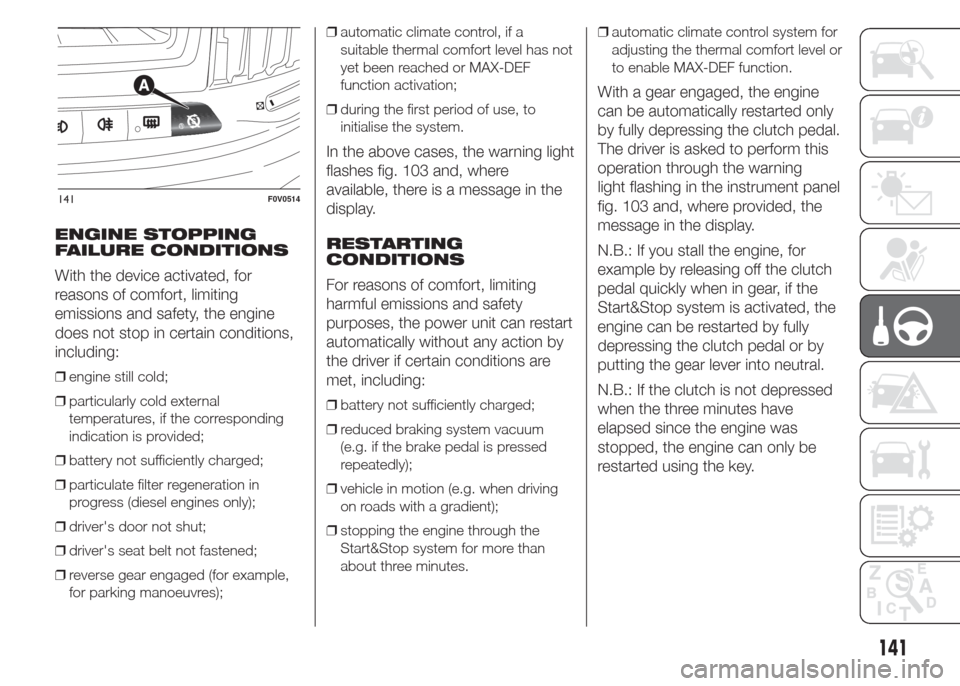
ENGINE STOPPING
FAILURE CONDITIONS
With the device activated, for
reasons of comfort, limiting
emissions and safety, the engine
does not stop in certain conditions,
including:
❒engine still cold;
❒particularly cold external
temperatures, if the corresponding
indication is provided;
❒battery not sufficiently charged;
❒particulate filter regeneration in
progress (diesel engines only);
❒driver's door not shut;
❒driver's seat belt not fastened;
❒reverse gear engaged (for example,
for parking manoeuvres);❒automatic climate control, if a
suitable thermal comfort level has not
yet been reached or MAX-DEF
function activation;
❒during the first period of use, to
initialise the system.
In the above cases, the warning light
flashes fig. 103 and, where
available, there is a message in the
display.
RESTARTING
CONDITIONS
For reasons of comfort, limiting
harmful emissions and safety
purposes, the power unit can restart
automatically without any action by
the driver if certain conditions are
met, including:
❒battery not sufficiently charged;
❒reduced braking system vacuum
(e.g. if the brake pedal is pressed
repeatedly);
❒vehicle in motion (e.g. when driving
on roads with a gradient);
❒stopping the engine through the
Start&Stop system for more than
about three minutes.❒automatic climate control system for
adjusting the thermal comfort level or
to enable MAX-DEF function.
With a gear engaged, the engine
can be automatically restarted only
by fully depressing the clutch pedal.
The driver is asked to perform this
operation through the warning
light flashing in the instrument panel
fig. 103 and, where provided, the
message in the display.
N.B.: If you stall the engine, for
example by releasing off the clutch
pedal quickly when in gear, if the
Start&Stop system is activated, the
engine can be restarted by fully
depressing the clutch pedal or by
putting the gear lever into neutral.
N.B.: If the clutch is not depressed
when the three minutes have
elapsed since the engine was
stopped, the engine can only be
restarted using the key.
141F0V0514
141
Page 146 of 323
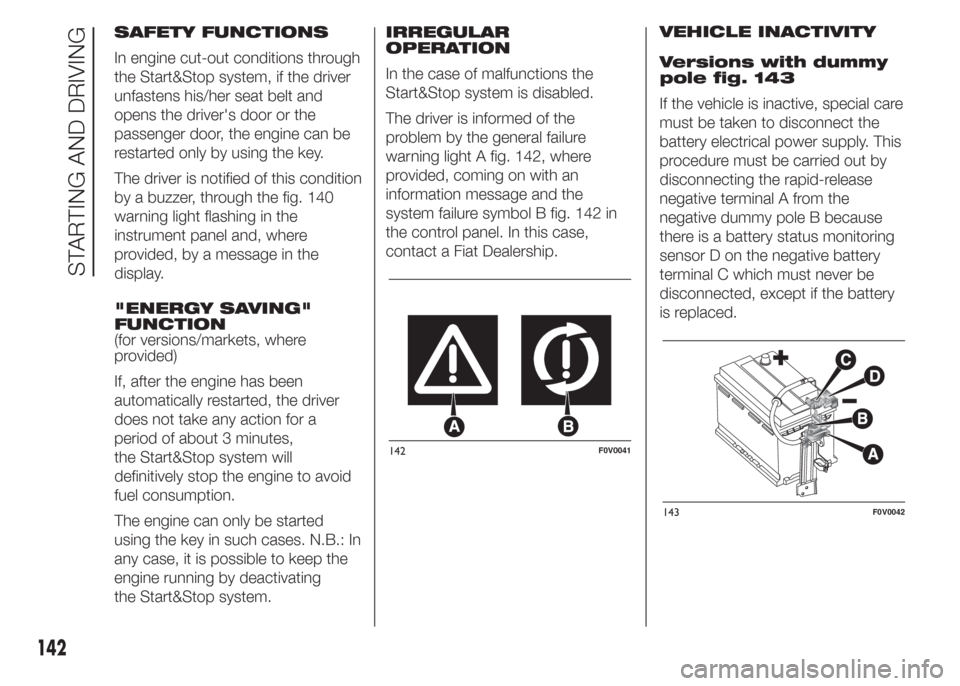
SAFETY FUNCTIONS
In engine cut-out conditions through
the Start&Stop system, if the driver
unfastens his/her seat belt and
opens the driver's door or the
passenger door, the engine can be
restarted only by using the key.
The driver is notified of this condition
by a buzzer, through the fig. 140
warning light flashing in the
instrument panel and, where
provided, by a message in the
display.
"ENERGY SAVING"
FUNCTION
(for versions/markets, where
provided)
If, after the engine has been
automatically restarted, the driver
does not take any action for a
period of about 3 minutes,
the Start&Stop system will
definitively stop the engine to avoid
fuel consumption.
The engine can only be started
using the key in such cases. N.B.: In
any case, it is possible to keep the
engine running by deactivating
the Start&Stop system.IRREGULAR
OPERATION
In the case of malfunctions the
Start&Stop system is disabled.
The driver is informed of the
problem by the general failure
warning light A fig. 142, where
provided, coming on with an
information message and the
system failure symbol B fig. 142 in
the control panel. In this case,
contact a Fiat Dealership.VEHICLE INACTIVITY
Versions with dummy
pole fig. 143
If the vehicle is inactive, special care
must be taken to disconnect the
battery electrical power supply. This
procedure must be carried out by
disconnecting the rapid-release
negative terminal A from the
negative dummy pole B because
there is a battery status monitoring
sensor D on the negative battery
terminal C which must never be
disconnected, except if the battery
is replaced.
142F0V0041
143F0V0042
142
STARTING AND DRIVING
Page 148 of 323
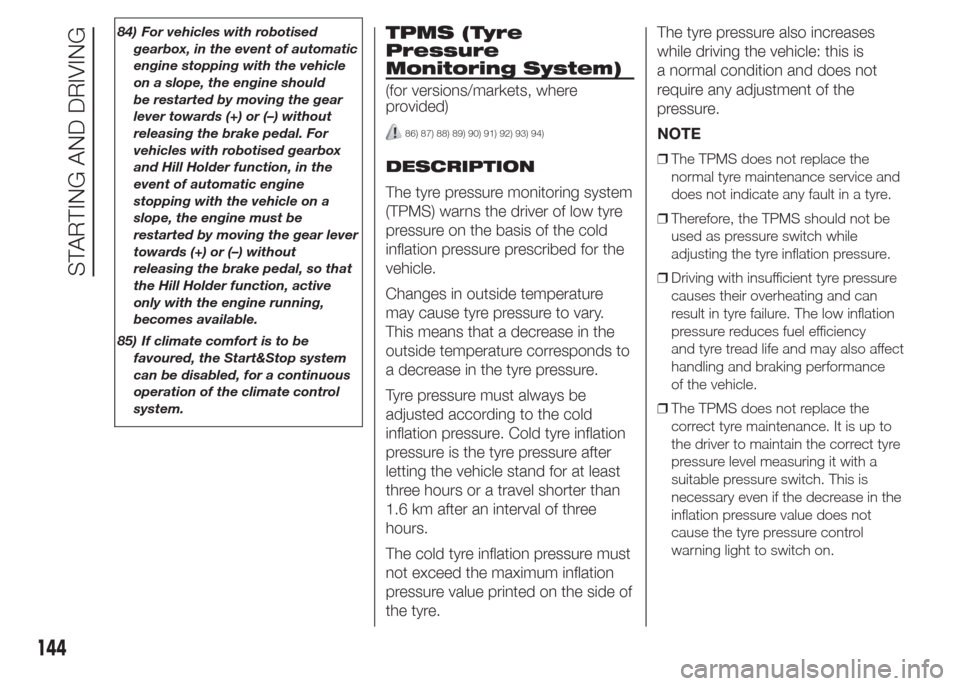
84) For vehicles with robotised
gearbox, in the event of automatic
engine stopping with the vehicle
on a slope, the engine should
be restarted by moving the gear
lever towards (+) or (–) without
releasing the brake pedal. For
vehicles with robotised gearbox
and Hill Holder function, in the
event of automatic engine
stopping with the vehicle on a
slope, the engine must be
restarted by moving the gear lever
towards (+) or (–) without
releasing the brake pedal, so that
the Hill Holder function, active
only with the engine running,
becomes available.
85) If climate comfort is to be
favoured, the Start&Stop system
can be disabled, for a continuous
operation of the climate control
system.TPMS (Tyre
Pressure
Monitoring System)
(for versions/markets, where
provided)
86) 87) 88) 89) 90) 91) 92) 93) 94)
DESCRIPTION
The tyre pressure monitoring system
(TPMS) warns the driver of low tyre
pressure on the basis of the cold
inflation pressure prescribed for the
vehicle.
Changes in outside temperature
may cause tyre pressure to vary.
This means that a decrease in the
outside temperature corresponds to
a decrease in the tyre pressure.
Tyre pressure must always be
adjusted according to the cold
inflation pressure. Cold tyre inflation
pressure is the tyre pressure after
letting the vehicle stand for at least
three hours or a travel shorter than
1.6 km after an interval of three
hours.
The cold tyre inflation pressure must
not exceed the maximum inflation
pressure value printed on the side of
the tyre.The tyre pressure also increases
while driving the vehicle: this is
a normal condition and does not
require any adjustment of the
pressure.
NOTE❒The TPMS does not replace the
normal tyre maintenance service and
does not indicate any fault in a tyre.
❒Therefore, the TPMS should not be
used as pressure switch while
adjusting the tyre inflation pressure.
❒Driving with insufficient tyre pressure
causes their overheating and can
result in tyre failure. The low inflation
pressure reduces fuel efficiency
and tyre tread life and may also affect
handling and braking performance
of the vehicle.
❒The TPMS does not replace the
correct tyre maintenance. It is up to
the driver to maintain the correct tyre
pressure level measuring it with a
suitable pressure switch. This is
necessary even if the decrease in the
inflation pressure value does not
cause the tyre pressure control
warning light to switch on.
144
STARTING AND DRIVING
Page 149 of 323
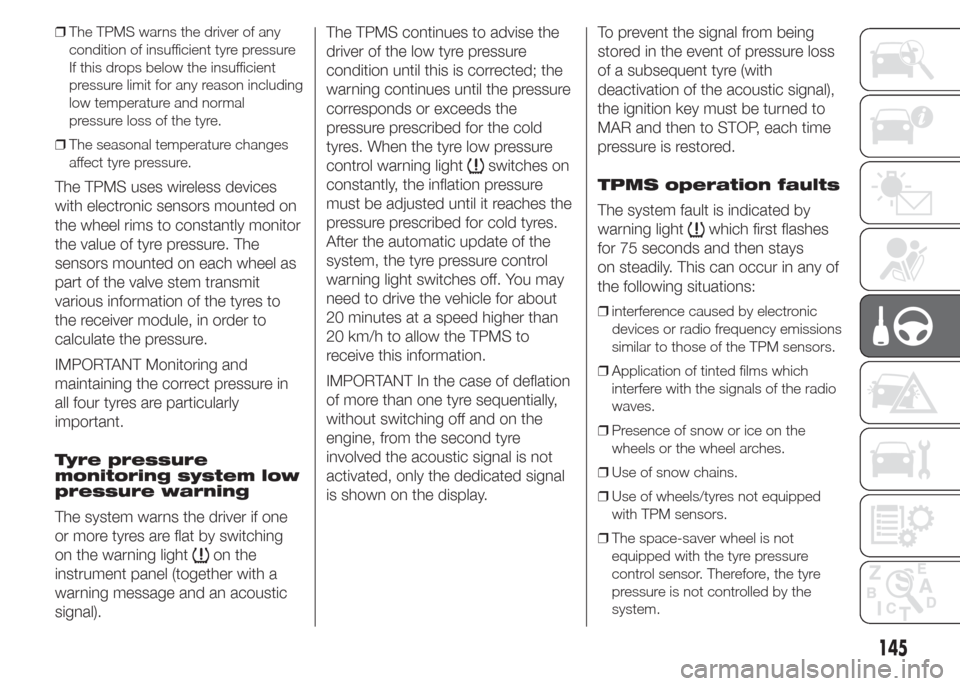
❒The TPMS warns the driver of any
condition of insufficient tyre pressure
If this drops below the insufficient
pressure limit for any reason including
low temperature and normal
pressure loss of the tyre.
❒The seasonal temperature changes
affect tyre pressure.
The TPMS uses wireless devices
with electronic sensors mounted on
the wheel rims to constantly monitor
the value of tyre pressure. The
sensors mounted on each wheel as
part of the valve stem transmit
various information of the tyres to
the receiver module, in order to
calculate the pressure.
IMPORTANT Monitoring and
maintaining the correct pressure in
all four tyres are particularly
important.
Tyre pressure
monitoring system low
pressure warning
The system warns the driver if one
or more tyres are flat by switching
on the warning light
on the
instrument panel (together with a
warning message and an acoustic
signal).The TPMS continues to advise the
driver of the low tyre pressure
condition until this is corrected; the
warning continues until the pressure
corresponds or exceeds the
pressure prescribed for the cold
tyres. When the tyre low pressure
control warning light
switches on
constantly, the inflation pressure
must be adjusted until it reaches the
pressure prescribed for cold tyres.
After the automatic update of the
system, the tyre pressure control
warning light switches off. You may
need to drive the vehicle for about
20 minutes at a speed higher than
20 km/h to allow the TPMS to
receive this information.
IMPORTANT In the case of deflation
of more than one tyre sequentially,
without switching off and on the
engine, from the second tyre
involved the acoustic signal is not
activated, only the dedicated signal
is shown on the display.To prevent the signal from being
stored in the event of pressure loss
of a subsequent tyre (with
deactivation of the acoustic signal),
the ignition key must be turned to
MAR and then to STOP, each time
pressure is restored.
TPMS operation faults
The system fault is indicated by
warning light
which first flashes
for 75 seconds and then stays
on steadily. This can occur in any of
the following situations:
❒interference caused by electronic
devices or radio frequency emissions
similar to those of the TPM sensors.
❒Application of tinted films which
interfere with the signals of the radio
waves.
❒Presence of snow or ice on the
wheels or the wheel arches.
❒Use of snow chains.
❒Use of wheels/tyres not equipped
with TPM sensors.
❒The space-saver wheel is not
equipped with the tyre pressure
control sensor. Therefore, the tyre
pressure is not controlled by the
system.
145
Page 150 of 323
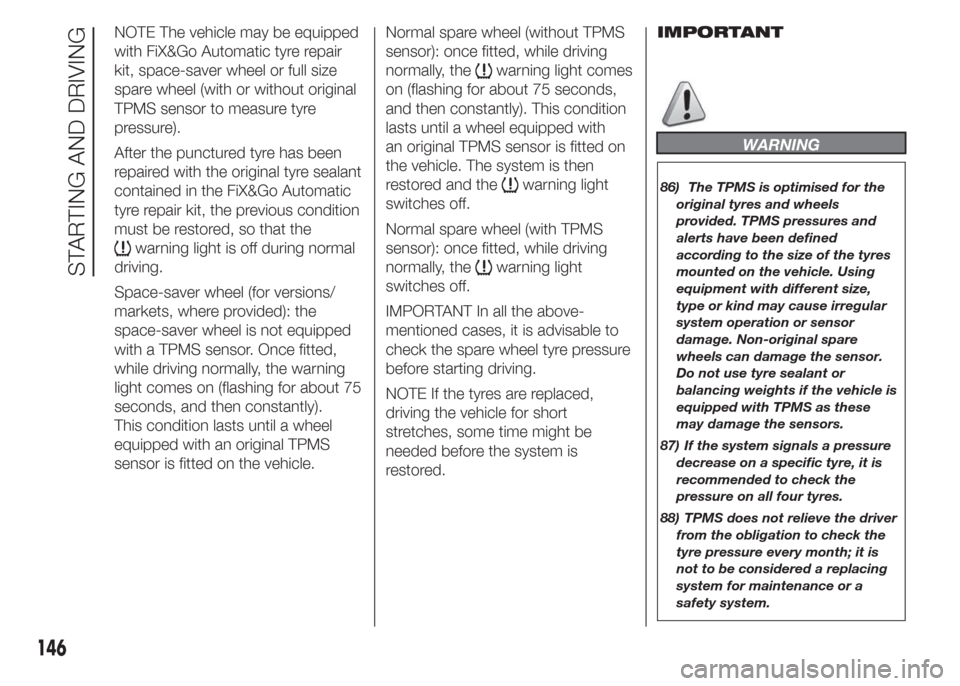
NOTE The vehicle may be equipped
with FiX&Go Automatic tyre repair
kit, space-saver wheel or full size
spare wheel (with or without original
TPMS sensor to measure tyre
pressure).
After the punctured tyre has been
repaired with the original tyre sealant
contained in the FiX&Go Automatic
tyre repair kit, the previous condition
must be restored, so that the
warning light is off during normal
driving.
Space-saver wheel (for versions/
markets, where provided): the
space-saver wheel is not equipped
with a TPMS sensor. Once fitted,
while driving normally, the warning
light comes on (flashing for about 75
seconds, and then constantly).
This condition lasts until a wheel
equipped with an original TPMS
sensor is fitted on the vehicle.Normal spare wheel (without TPMS
sensor): once fitted, while driving
normally, the
warning light comes
on (flashing for about 75 seconds,
and then constantly). This condition
lasts until a wheel equipped with
an original TPMS sensor is fitted on
the vehicle. The system is then
restored and the
warning light
switches off.
Normal spare wheel (with TPMS
sensor): once fitted, while driving
normally, the
warning light
switches off.
IMPORTANT In all the above-
mentioned cases, it is advisable to
check the spare wheel tyre pressure
before starting driving.
NOTE If the tyres are replaced,
driving the vehicle for short
stretches, some time might be
needed before the system is
restored.IMPORTANT
WARNING
86) The TPMS is optimised for the
original tyres and wheels
provided. TPMS pressures and
alerts have been defined
according to the size of the tyres
mounted on the vehicle. Using
equipment with different size,
type or kind may cause irregular
system operation or sensor
damage. Non-original spare
wheels can damage the sensor.
Do not use tyre sealant or
balancing weights if the vehicle is
equipped with TPMS as these
may damage the sensors.
87) If the system signals a pressure
decrease on a specific tyre, it is
recommended to check the
pressure on all four tyres.
88) TPMS does not relieve the driver
from the obligation to check the
tyre pressure every month; it is
not to be considered a replacing
system for maintenance or a
safety system.
146
STARTING AND DRIVING
Page 152 of 323
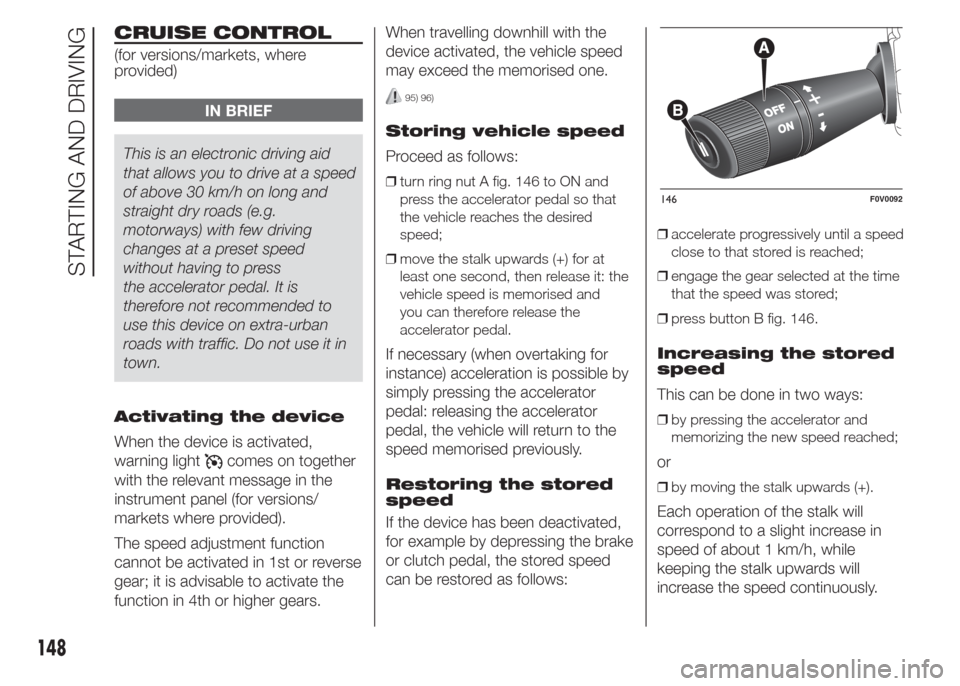
CRUISE CONTROL
(for versions/markets, where
provided)
IN BRIEF
This is an electronic driving aid
that allows you to drive at a speed
of above 30 km/h on long and
straight dry roads (e.g.
motorways) with few driving
changes at a preset speed
without having to press
the accelerator pedal. It is
therefore not recommended to
use this device on extra-urban
roads with traffic. Do not use it in
town.
Activating the device
When the device is activated,
warning light
comes on together
with the relevant message in the
instrument panel (for versions/
markets where provided).
The speed adjustment function
cannot be activated in 1st or reverse
gear; it is advisable to activate the
function in 4th or higher gears.When travelling downhill with the
device activated, the vehicle speed
may exceed the memorised one.
95) 96)
Storing vehicle speed
Proceed as follows:
❒turn ring nut A fig. 146 to ON and
press the accelerator pedal so that
the vehicle reaches the desired
speed;
❒move the stalk upwards (+) for at
least one second, then release it: the
vehicle speed is memorised and
you can therefore release the
accelerator pedal.
If necessary (when overtaking for
instance) acceleration is possible by
simply pressing the accelerator
pedal: releasing the accelerator
pedal, the vehicle will return to the
speed memorised previously.
Restoring the stored
speed
If the device has been deactivated,
for example by depressing the brake
or clutch pedal, the stored speed
can be restored as follows:
❒accelerate progressively until a speed
close to that stored is reached;
❒engage the gear selected at the time
that the speed was stored;
❒press button B fig. 146.
Increasing the stored
speed
This can be done in two ways:
❒by pressing the accelerator and
memorizing the new speed reached;
or
❒by moving the stalk upwards (+).
Each operation of the stalk will
correspond to a slight increase in
speed of about 1 km/h, while
keeping the stalk upwards will
increase the speed continuously.
146F0V0092
148
STARTING AND DRIVING
Page 153 of 323
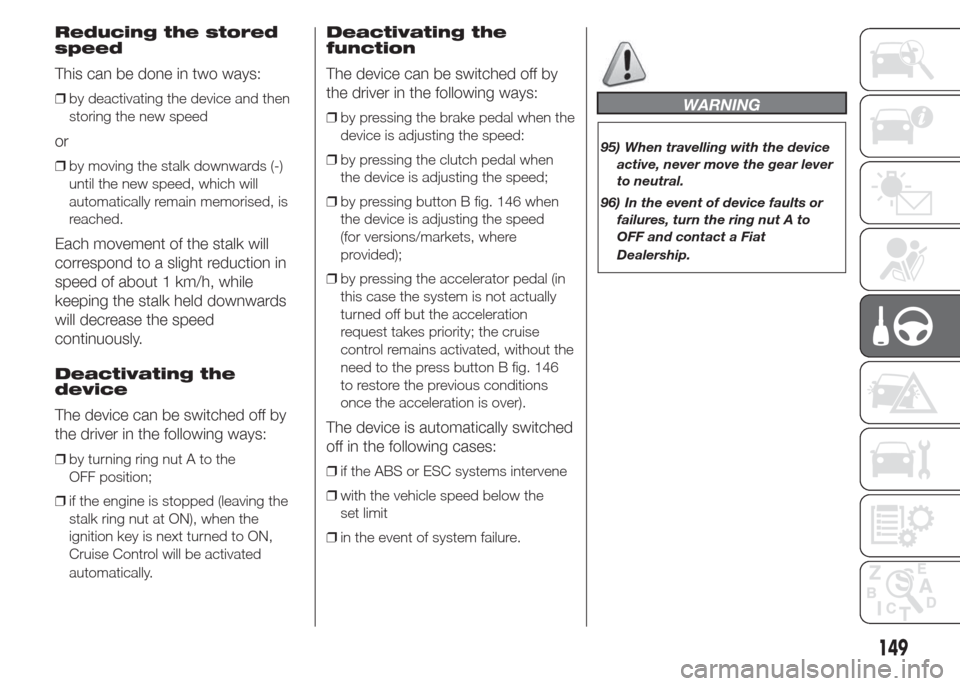
Reducing the stored
speed
This can be done in two ways:
❒by deactivating the device and then
storing the new speed
or
❒by moving the stalk downwards (-)
until the new speed, which will
automatically remain memorised, is
reached.
Each movement of the stalk will
correspond to a slight reduction in
speed of about 1 km/h, while
keeping the stalk held downwards
will decrease the speed
continuously.
Deactivating the
device
The device can be switched off by
the driver in the following ways:
❒by turning ring nut A to the
OFF position;
❒if the engine is stopped (leaving the
stalk ring nut at ON), when the
ignition key is next turned to ON,
Cruise Control will be activated
automatically.
Deactivating the
function
The device can be switched off by
the driver in the following ways:
❒by pressing the brake pedal when the
device is adjusting the speed:
❒by pressing the clutch pedal when
the device is adjusting the speed;
❒by pressing button B fig. 146 when
the device is adjusting the speed
(for versions/markets, where
provided);
❒by pressing the accelerator pedal (in
this case the system is not actually
turned off but the acceleration
request takes priority; the cruise
control remains activated, without the
need to the press button B fig. 146
to restore the previous conditions
once the acceleration is over).
The device is automatically switched
off in the following cases:
❒if the ABS or ESC systems intervene
❒with the vehicle speed below the
set limit
❒in the event of system failure.
WARNING
95) When travelling with the device
active, never move the gear lever
to neutral.
96) In the event of device faults or
failures, turn the ring nut A to
OFF and contact a Fiat
Dealership.
149
Page 154 of 323
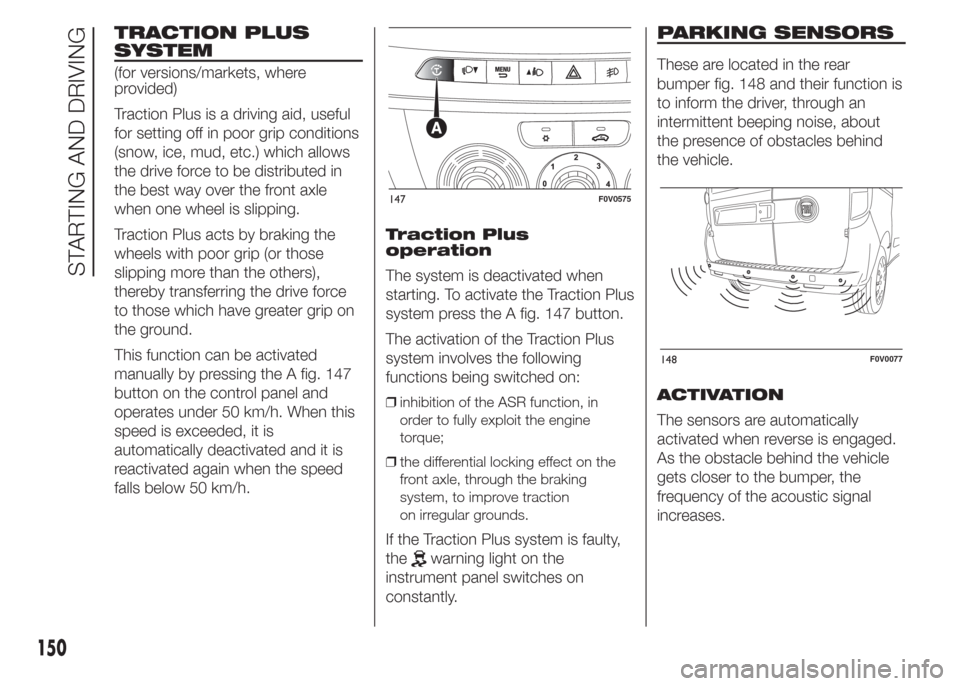
TRACTION PLUS
SYSTEM
(for versions/markets, where
provided)
Traction Plus is a driving aid, useful
for setting off in poor grip conditions
(snow, ice, mud, etc.) which allows
the drive force to be distributed in
the best way over the front axle
when one wheel is slipping.
Traction Plus acts by braking the
wheels with poor grip (or those
slipping more than the others),
thereby transferring the drive force
to those which have greater grip on
the ground.
This function can be activated
manually by pressing the A fig. 147
button on the control panel and
operates under 50 km/h. When this
speed is exceeded, it is
automatically deactivated and it is
reactivated again when the speed
falls below 50 km/h.Traction Plus
operation
The system is deactivated when
starting. To activate the Traction Plus
system press the A fig. 147 button.
The activation of the Traction Plus
system involves the following
functions being switched on:
❒inhibition of the ASR function, in
order to fully exploit the engine
torque;
❒the differential locking effect on the
front axle, through the braking
system, to improve traction
on irregular grounds.
If the Traction Plus system is faulty,
the
warning light on the
instrument panel switches on
constantly.
PARKING SENSORS
These are located in the rear
bumper fig. 148 and their function is
to inform the driver, through an
intermittent beeping noise, about
the presence of obstacles behind
the vehicle.
ACTIVATION
The sensors are automatically
activated when reverse is engaged.
As the obstacle behind the vehicle
gets closer to the bumper, the
frequency of the acoustic signal
increases.
147F0V0575
148F0V0077
150
STARTING AND DRIVING